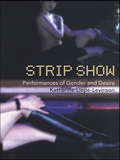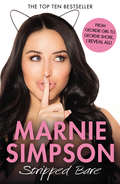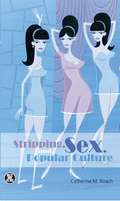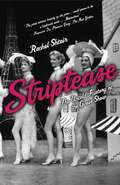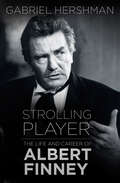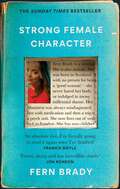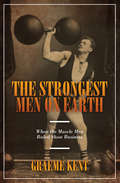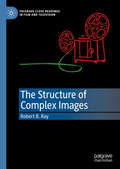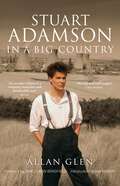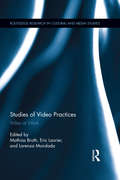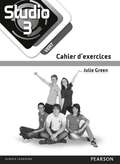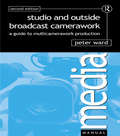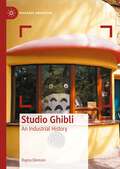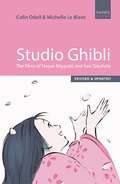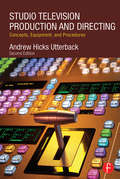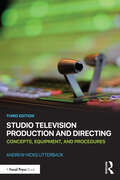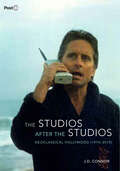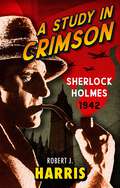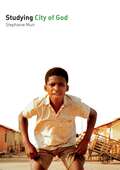- Table View
- List View
Strip Show: Performances of Gender and Desire (Gender in Performance)
by Katherine Liepe-LevinsonThis book offers an account of an unprecedented North American study of contemporary female and male strip shows. It particularly focuses on the contradictory sex roles, cultural positions, and performance practices of 'straight' strip shows during their second heyday in the early 1990s.Katherine Liepe-Levinson's research took her to over seventy different strip bars, clubs, theatres and sex emporiums ranging from elaborate lap-dancing and couch-dancing 'gentlemen's' clubs in New York, Houston, and San Francisco; to Peoria's onetime duplex cabaret where women strip for men downstairs, and men for women upstairs; to the nightclubs of Montreal where female and male performers displayed the 'Full Monty'. Liepe-Levinson's intriguing, comprehensive study concentrates on the cultural and theatrical elements of the strip shows themselves including the geographic locations and interior designs of the clubs, the choreography and costumes of the dancers and the all-important participation of the audience. She draws upon a variety of methodologies as well as interviews with performers to explore how the strip show's cultural and theatrical aspects simultaneously uphold and break traditional sex roles. Her findings readily complicate several of the most prominent and prevalent theories about sexual representation, gender and desire.
Strip Show: Performances of Gender and Desire (Gender in Performance)
by Katherine Liepe-LevinsonThis book offers an account of an unprecedented North American study of contemporary female and male strip shows. It particularly focuses on the contradictory sex roles, cultural positions, and performance practices of 'straight' strip shows during their second heyday in the early 1990s.Katherine Liepe-Levinson's research took her to over seventy different strip bars, clubs, theatres and sex emporiums ranging from elaborate lap-dancing and couch-dancing 'gentlemen's' clubs in New York, Houston, and San Francisco; to Peoria's onetime duplex cabaret where women strip for men downstairs, and men for women upstairs; to the nightclubs of Montreal where female and male performers displayed the 'Full Monty'. Liepe-Levinson's intriguing, comprehensive study concentrates on the cultural and theatrical elements of the strip shows themselves including the geographic locations and interior designs of the clubs, the choreography and costumes of the dancers and the all-important participation of the audience. She draws upon a variety of methodologies as well as interviews with performers to explore how the strip show's cultural and theatrical aspects simultaneously uphold and break traditional sex roles. Her findings readily complicate several of the most prominent and prevalent theories about sexual representation, gender and desire.
Stripped Bare
by Marnie SimpsonThe Sunday Times bestseller from one of the UK's best-loved television stars.'I'm a girl with a crazy head, a big heart and even bigger dreams. If I've made mistakes, I've learned from them. But whatever's happened to me , I can never say that life's been boring.'From a young North-East girl to star of the small screen, Geordie Shore personality Marnie Simpson is here to lift the lid and reveal all.Marnie Simpson is one of the UK's best-loved TV personalities, first bursting on to our screens in the TV series Geordie Shore. Marnie lifts the lid on her life with characteristic punch – uncover the real Marnie through the ups and downs of growing up in Newcastle to the hilarious and dramatic antics of Geordie Shore and Celebrity Big Brother. Marnie reveals all – and everything in between!
Stripping, Sex, and Popular Culture (Dress, Body, Culture)
by Catherine M. RoachAt the heart of Stripping, Sex, and Popular Culture lies a very personal story, of author Catherine Roach's response to the decision of her life-long best friend to become an exotic dancer. Catherine and Marie grew up together in Canada and moved to the USA to enroll in PhD programs at prestigious universities. For various reasons, Marie left her program and instead chose to work as a stripper. The author, at first troubled and yet fascinated by her friend's decision, follows Marie's journey into the world of stripping as an observer and analyst. She finds that this world raises complex questions about gender, sexuality, fantasy, feminism, and even spirituality. Moving from first hand interviews with dancers and others, the book broadens into a provocative and accessible examination of the current popularity of "striptease culture," with sex-saturated media imagery, thongs gone mainstream, and stripper aerobics at your local gym. Stripping, Sex, and Popular Culture scrutinizes the naked truth of a lucrative industry whose norms are increasingly at the center of contemporary society.A PDF version of this book is available for free in open access via the OAPEN Library platform, www.oapen.org
Striptease: The Untold History of the Girlie Show
by Rachel ShteirStriptease recreates the combustible mixture of license, independence, and sexual curiosity that allowed strippers to thrive for nearly a century. Rachel Shteir brings to life striptease's Golden Age, the years between the Jazz Age and the Sexual Revolution, when strippers performed around the country, in burlesque theatres, nightclubs, vaudeville houses, carnivals, fairs, and even in glorious palaces on the Great White Way. Taking us behind the scenes, Shteir introduces us to a diverse cast of characters that collided on the burlesque stage, from tight-laced political reformers and flamboyant impresarios, to drag queens, shimmy girls, cootch dancers, tit serenaders, and even girls next door, lured into the profession by big-city aspirations. Throughout the book, readers will find essential profiles of famed performers, including Gypsy Rose Lee, "the Literary Stripper"; Lili St. Cyr, the 1950s mistress of exotic striptease; and Blaze Starr, the "human heat wave," who literally set the stage on fire. Striptease is an insightful and entertaining portrait of an art form at once reviled and embraced by the American public. Blending careful research and vivid narration, Rachel Shteir captures striptease's combination of sham and seduction while illuminating its surprisingly persistent hold on the American imagination.
Strolling Player: The Life and Career of Albert Finney
by Gabriel HershmanAlbert Finney was a Salford-born, homework-hating bookie’s son who broke the social barriers of British film. He did his share of roistering, and yet outlived his contemporaries and dodged typecasting to become a five-time Oscar nominee and one of our most durable international stars. Bon vivant, perennial rebel, self-effacing character actor, charismatic charmer, mentor to a generation of working-class artists, a byword for professionalism, lover of horseflesh and female flesh – Albert Finney is all these things and more. Gabriel Hershman’s colourful and riveting account of Finney’s life and work, drawing on interviews with many of his directors and co-stars, examines how one of Britain’s greatest actors built a glittering career without sacrificing his integrity.
Strong Female Character: Nero Book Awards Winner
by Fern BradyBRITISH BOOK OF THE YEAR: AUDIOBOOK WINNER 2024NERO BOOK AWARDS WINNER 2023WINNER, NON FICTION BOOK 2023, BOOKS ARE MY BAG AWARDSSHORTLIST, BOOKSHOP.ORG INDIE CHAMPIONSSHORTLIST, AMAZON NON-FICTION BOOK OF THE YEARSHORTLIST, GOODREADS CHOICE BOOK OF THE YEARAudible Books of the Year 2023The Times Books of the Year 2023Apple Best Audiobooks of 2023BOOKSHOP.ORG Book of the Month January 2024THE SUNDAY TIMES BESTSELLER'I tore through this hilarious, smart, sad, revealing book' - Bob Odenkirk'Funny, sharp and has incredible clarity' - Jon Ronson'An absolute riot. I'm literally going to read it again once I've finished, and I'm a miserable bastard...it's a belter' - FRANKIE BOYLE'Strong Female Character is a testament to the importance of self-knowledge.' - Rachael Healy, The GuardianA summary of my book:1. I'm diagnosed with autism 20 years after telling a doctor I had it.2. My terrible Catholic childhood: I hate my parents etc.3. My friendship with an elderly man who runs the corner shop and is definitely not trying to groom me. I get groomed.4. Homelessness.5. Stripping.6. More stripping but with more nervous breakdowns.7. I hate everyone at uni and live with a psycho etc.8. REDACTED as too spicy.9. After everyone tells me I don't look autistic, I try to cure my autism and get addicted to Xanax.10. REDACTED as too embarrassing.'Fern's book, like everything she does, is awesome. Incredibly funny, and so unapologetically frank that I feel genuinely sorry for her lawyers.' - PHIL WANG'Of course it's funny - it's Fern Brady - but this book is also deeply moving and eye-opening'- ADAM KAY'It made me laugh out loud and broke my heart and made me weep...I hope absolutely everyone reads this, and it makes them kinder and more curious about the way we all live' - DAISY BUCHANAN'Glorious. Frank but nuanced, a memoir that doesn't sacrifice voice or self-awareness. And it has brilliant things to say about being autistic and being funny' - ELLE MCNICOLL'A set text for all of us in 2023' - DEBORAH FRANCES-WHITE'Fern is a brilliant, beautiful writer with a unique voice and even more unique story. Astute, honest and very, very funny.' - LOU SANDERS'So funny and brilliant' - HOLLY SMALE'Witty, dry, and gimlet-eyed, Strong Female Character is a necessary corrective. Brady offers a compelling, messy, highly resonant portrait of what masked Autism feels like.' - Devon Price, author of Unmasking Autism
The Strongest Men on Earth: When the Muscle Men Ruled Show Business
by Graeme KentThey claimed to be the mightiest men in the world. For twenty-five years, before the outbreak of the First World War, professional strongmen were the pop idols of their day. Performing apparently incredible feats of strength, they strutted across stages and topped the bills everywhere, earning thousands of pounds a week. Fans included royalty, heads of state, politicians and leading figures in the literary and artistic worlds, as well as hundreds of thousands of ordinary men and women, all revelling in the antics of these larger-than-life characters. Seeking to outdo each other in death-defying deeds, the strongmen's performances were thrilling and dangerous: lifting elephants, horses, pianos and their players; breaking chains with their biceps; supporting thirty men on a plank suspended on their shoulders. Some strongmen succeeded beyond their wildest dreams. Eugen Sandow, a great self-publicist, was appointed physical culture adviser to King George V. His great rival, the bombastic Charles Sampson, toured the world with his blatant cheating and rigged strongman displays until one day the elephant he claimed to be lifting remained suspended in mid-air. Georg Hackenschmidt, the Russian Lion, was so popular that Theodore Roosevelt himself declared wistfully that he would rather be 'Hack' than President of the USA. In The Strongest Men on Earth, Graeme Kent vividly brings to life the world of strongmen (and women), and shares the stories that defined a sporting and show-business era.
The Structure of Complex Images (Palgrave Close Readings in Film and Television)
by Robert B. RayAfter over a century of existence, the cinema still has its mysteries. Why, for example, is the job we call movie stardom unlike any other in the world? How do films provide so much unconcealed information that we fail to notice? What makes it hard to define what counts as “acting”? How do movies like Casablanca and Breathless store the film and world histories of their generations? How can we reconcile auteurism’s celebration of the movie director’s authority with the camera’s automatism? Why have the last four decades of film criticism so often neglected such questions? After beginning with an overview of film studies, this book proposes a shift from predictable theoretical approaches to models that acknowledge the perplexities and mysteries of the movies. Deriving methods from cinephilia, Wittgenstein, Richard Rorty, Stanley Cavell, Eleanor Duckworth, V. F. Perkins, and James Naremore, Robert B. Ray offers close readings that call attention to what we have missed in such classic films as La Règle du Jeu, It Happened One Night, It’s a Wonderful Life, Vertigo, Holiday, The Philadelphia Story, Casablanca, Breathless, and Tickets.
Stuart Adamson: In a Big Country
by Allan GlenThis is the book that fans of the Skids, Big Country and the Raphaels have been waiting for - a critical perspective not only of Adamson's music and its wider cultural influence, but also the excesses of fame and how the music business really works. Stuart Adamson: In a Big Country tells the story of how a teenager who was raised in a small Fife village released his first single at 19, wrote three Top 40 albums in the next three years and was written off as a has-been at 23, but then went on to form a new band and sell more than 10 million records worldwide, touring with the Rolling Stones and David Bowie. Although Stuart Adamson was one of the most respected and popular figures in the music industry, his personal life was complex - depression, alcoholism and estrangement - and ultimately tragic, ending with his suicide in a Hawaiian hotel in December 2001.
Studies of Video Practices: Video at Work (Routledge Research in Cultural and Media Studies #63)
by Mathias Broth Eric Laurier Lorenza MondadaThe last two decades have seen a rapid increase in the production and consumption of video by both professionals and amateurs. The near ubiquity of devices with video cameras and the rise of sites like YouTube have lead to the growth and transformation of the practices of producing, circulating, and viewing video, whether it be in households, workplaces, or research laboratories. This volume builds a foundation for studies of activities based in and around video production and consumption. It contributes to the interdisciplinary field of visual methodology, investigating how video functions as a resource for a variety of actors and professions.
Studies of Video Practices: Video at Work (Routledge Research in Cultural and Media Studies)
by Mathias Broth Eric Laurier Lorenza MondadaThe last two decades have seen a rapid increase in the production and consumption of video by both professionals and amateurs. The near ubiquity of devices with video cameras and the rise of sites like YouTube have lead to the growth and transformation of the practices of producing, circulating, and viewing video, whether it be in households, workplaces, or research laboratories. This volume builds a foundation for studies of activities based in and around video production and consumption. It contributes to the interdisciplinary field of visual methodology, investigating how video functions as a resource for a variety of actors and professions.
Studio 3 Vert Workbook for Pack (11-14 French) (PDF)
by Julie GreenStudio 3 is split into parallel differentiated levels - Studio 3 Vert covers NC Levels 1-5, and is designed to support pupils with practice and consolidation through a wider variety of activity types.
Studio and Outside Broadcast Camerawork
by Peter WardStudio and outside broadcast is often done with more than one camera and has its own distinct discipline and operational procedures. Many camera operators now start with single camera operations and have little or no experience of the skills required for multi-camera operation, whereas it used to be the other way round. This book prepared newcomers to multi-camerawork and the techniques required to produce professional results. Studio and Outside Broadcast Camerawork is a revised edition of Multi-Camera Camerawork, including new material on widescreen shooting and an update on BBC (and worldwide) policy of 'shoot and protect' for dual aspect ratio format production.
Studio and Outside Broadcast Camerawork: A Guide To Multi-camerawork Production
by Peter WardStudio and outside broadcast is often done with more than one camera and has its own distinct discipline and operational procedures. Many camera operators now start with single camera operations and have little or no experience of the skills required for multi-camera operation, whereas it used to be the other way round. This book prepared newcomers to multi-camerawork and the techniques required to produce professional results. Studio and Outside Broadcast Camerawork is a revised edition of Multi-Camera Camerawork, including new material on widescreen shooting and an update on BBC (and worldwide) policy of 'shoot and protect' for dual aspect ratio format production.
Studio Ghibli: An Industrial History (Palgrave Animation)
by Rayna DenisonStudio Ghibli: An Industrial History takes us deep into the production world of the animation studio co-founded by Oscar-winning director Hayao Miyazaki. It investigates the production culture at Studio Ghibli and considers how the studio has become one of the world’s most famous animation houses. The book breaks with the usual methods for studying Miyazaki and Ghibli’s films, going beyond textual analysis to unpack the myths that have grown up around the studio during its long history. It looks back at over 35 years of filmmaking by Miyazaki and other Ghibli directors, reconsidering the studio’s reputation for egalitarianism and feminism, re-examining its relationship to the art of cel and CG animation, investigating Studio Ghibli’s work outside of feature filmmaking from advertising to videogames and tackling the studio’s difficulties in finding new generations of directors to follow in the footsteps of Miyazaki and Isao Takahata. By reconstructing the history of Studio Ghibli through its own records, promotional documents and staff interviews, Studio Ghibli: An Industrial History offers a new perspective not just on Ghibli, but on the industrial history of Japanese animation.
Studio Ghibli: The films of Hayao Miyazaki and Isao Takahata - Third Edition
by Michelle Le Blanc Colin OdellThird Edition of this popular guide - with expanded and updated contentThe animations of Japan's Studio Ghibli are amongst the most respected in the movie industry. Their delightful films rank alongside the most popular non-English language films ever made, with each new eagerly anticipated release a guaranteed box office hit. Yet this highly profitable studio has remained fiercely independent, producing a stream of imaginative and individual animations. The studio's founders, the late Isao Takahata and Hayao Miyazaki (who is coming out of retirement again soon), have created timeless masterpieces. Although their films are distinctly Japanese, their themes are universal: humanity, community and a love for the environment. No other film studio, animation or otherwise, comes close to matching Ghibli for pure cinematic experience.This Kamera Book examines all their major works including Laputa: Castle in the Sky, Grave of the Fireflies, My Neighbour Totoro, Kiki's Delivery Service, Only Yesterday, Porco Rosso, Pom Poko, Whisper of the Heart, Princess Mononoke and Howl's Moving Castle, as well as the critically acclaimed Spirited Away and The Tale of Princess Kaguya. Odell and Le Blanc's informed analysis also considers Studio Ghibli features such as Hayao Miyazaki's Oscar-nominated final masterpiece The Wind Rises, When Marnie Was There and the recent co-productions, Ronja the Robber's Daughter and Red Turtle.'One of the most authoritative texts available. Whether you're a newcomer or a longtime fan, Studio Ghibli is well worth a read'- SciFi Now
Studio Television Production and Directing: Concepts, Equipment, and Procedures
by Andrew UtterbackMaster the fundamentals of studio production procedure and become an effective leader on set. Gain fluency in essential studio terms and technology and acquire the skills you need to make it in the industry. Elegant, accessible, and to the point, the second edition of Andrew H. Utterback’s Studio Television Production and Directing is your back-to-the-basics guide to studio-based lighting, set design, camera operations, floor direction, technical direction, audio capture, graphics, prompting, and assistant directing. Whether you are an established studio professional or a student looking to enter the field, this book provides you with the technical expertise you need to successfully coordinate live or taped studio television in the digital age. This new edition has been updated to include: A UK/Euro focused appendix, enhancing the book’s accessibility to students and professionals of television production around the world An advanced discussion of the job of the Director and the Command Cue Language Fresh discussion of tapeless protocols in the control room, Media Object Server newsroom control software (iNews), editing systems, switcher embedded image store, and DPM (DVE) Brand new sections on UHDTV (4K), set design, lighting design, microphones, multiviewers, media asset management, clip-servers, and the use of 2D and 3D animation Expanded coverage of clip types used in ENG and video journalism (VO, VO/SOT, and PKG) An all new companion website (www.focalpress.com/cw/utterback) with pre-recorded lectures by the author, sample video clips, an expanded full color image archive, vocabulary flashcards, and more Note: the companion website is still under development, but in the meantime the author's filmed lectures are all freely available on Youtube: https://www.youtube.com/channel/UCRp_aSpO0y8cDqLjFGZ2s9A
Studio Television Production and Directing: Concepts, Equipment, and Procedures
by Andrew UtterbackMaster the fundamentals of studio production procedure and become an effective leader on set. Gain fluency in essential studio terms and technology and acquire the skills you need to make it in the industry. Elegant, accessible, and to the point, the second edition of Andrew H. Utterback’s Studio Television Production and Directing is your back-to-the-basics guide to studio-based lighting, set design, camera operations, floor direction, technical direction, audio capture, graphics, prompting, and assistant directing. Whether you are an established studio professional or a student looking to enter the field, this book provides you with the technical expertise you need to successfully coordinate live or taped studio television in the digital age. This new edition has been updated to include: A UK/Euro focused appendix, enhancing the book’s accessibility to students and professionals of television production around the world An advanced discussion of the job of the Director and the Command Cue Language Fresh discussion of tapeless protocols in the control room, Media Object Server newsroom control software (iNews), editing systems, switcher embedded image store, and DPM (DVE) Brand new sections on UHDTV (4K), set design, lighting design, microphones, multiviewers, media asset management, clip-servers, and the use of 2D and 3D animation Expanded coverage of clip types used in ENG and video journalism (VO, VO/SOT, and PKG) An all new companion website (www.focalpress.com/cw/utterback) with pre-recorded lectures by the author, sample video clips, an expanded full color image archive, vocabulary flashcards, and more Note: the companion website is still under development, but in the meantime the author's filmed lectures are all freely available on Youtube: https://www.youtube.com/channel/UCRp_aSpO0y8cDqLjFGZ2s9A
Studio Television Production and Directing: Concepts, Equipment, and Procedures
by Andrew Hicks UtterbackThis updated third edition of Studio Television Production and Directing introduces readers to the basic fundamentals of studio and control room production. Accessible and focused, readers of this updated third edition will learn about essential studio and control room terminology and the common technology package. This book is your back-to-the-basics guide to common technology—including principles of directing, assistant directing, technical directing, playback, audio ops, basic studio lighting, an introduction to set design, camera ops, floor directing, story types (VO, VO/SOT, PKG), basic engineering, and more. Whether an established professional or a student, this book provides readers with the technical expertise to successfully coordinate live or recorded multicamera production. In this new edition, author Andrew Hicks Utterback offers an expanded glossary and new material on visualization walls, alternative camera mounts, basic engineering, and news narrative diagramming.
Studio Television Production and Directing: Concepts, Equipment, and Procedures
by Andrew Hicks UtterbackThis updated third edition of Studio Television Production and Directing introduces readers to the basic fundamentals of studio and control room production. Accessible and focused, readers of this updated third edition will learn about essential studio and control room terminology and the common technology package. This book is your back-to-the-basics guide to common technology—including principles of directing, assistant directing, technical directing, playback, audio ops, basic studio lighting, an introduction to set design, camera ops, floor directing, story types (VO, VO/SOT, PKG), basic engineering, and more. Whether an established professional or a student, this book provides readers with the technical expertise to successfully coordinate live or recorded multicamera production. In this new edition, author Andrew Hicks Utterback offers an expanded glossary and new material on visualization walls, alternative camera mounts, basic engineering, and news narrative diagramming.
The Studios after the Studios: Neoclassical Hollywood (1970-2010) (Post*45)
by J. D. ConnorModern Hollywood is dominated by a handful of studios: Columbia, Disney, Fox, Paramount, Universal, and Warner Bros. Threatened by independents in the 1970s, they returned to power in the 1980s, ruled unquestioned in the 1990s, and in the new millennium are again beseiged. But in the heyday of this new classical era, the major studios movies — their stories and styles — were astonishingly precise biographies of the studios that made them. Movies became product placements for their studios, advertising them to the industry, to their employees, and to the public at large. If we want to know how studios work—how studios think—we need to watch their films closely. How closely? Maniacally so. In a wide range of examples, The Studios after the Studios explores the gaps between story and backstory in order to excavate the hidden history of Hollywood's second great studio era.
A Study in Crimson: Sherlock Holmes: 1942
by Robert J. HarrisA killer going by the name of 'Crimson Jack' is stalking the wartime streets of London, murdering women on the exact dates of the infamous Jack the Ripper killings of 1888. Has the Ripper somehow returned from the grave? Is the selfstyled Crimson Jack a descendant of the original Jack or merely a madman obsessed with those notorious killings?In desperation Scotland Yard turn to Sherlock Holmes, the world’s greatest detective. Surely he is the one man who can sift fact from legend and track down Crimson Jack before he completes his tally of death. As Holmes and the faithful Watson tread the blacked out streets of London, death waits just around the corner.
Studying City of God (Studying Films)
by Stephanie MuirA leading example of a resurgent Latin American cinema – 'la buena onda' – in the early twenty-first century, City of God was a huge international popular and critical success. A combination of intoxicating, Hollywood-style genre film-making and hard-hitting, social-realist subject matter it was hailed as a masterpiece at Cannes in 2002 and seen by over 3 million people in Brazil, including the Brazilian cabinet. In Studying City of God, Stephanie Muir considers: The historical and industrial context of City of God – a brief history of Latin American cinema is followed by a more detailed account of film-making in Brazil – from light-hearted travelogues to Cinema Novo and after – all in the context of increasing globalisation; Narrative and Genre – how the film uses the components of narrative in a complex way, ex-perimentally manipulating time while using traditional genre conventions that are highly recognisable to mainstream audiences; Film language – the formal elements of the film are dissected through a detailed illustrated analysis of the kinetic, scene setting opening sequence; Audience responses – from establishment critical reaction to fan-based Internet sites and student feedback; Representation and Ideology – just how 'authentic' can a film such as City of God hope to be? Does its style overwhelm its subject matter?
